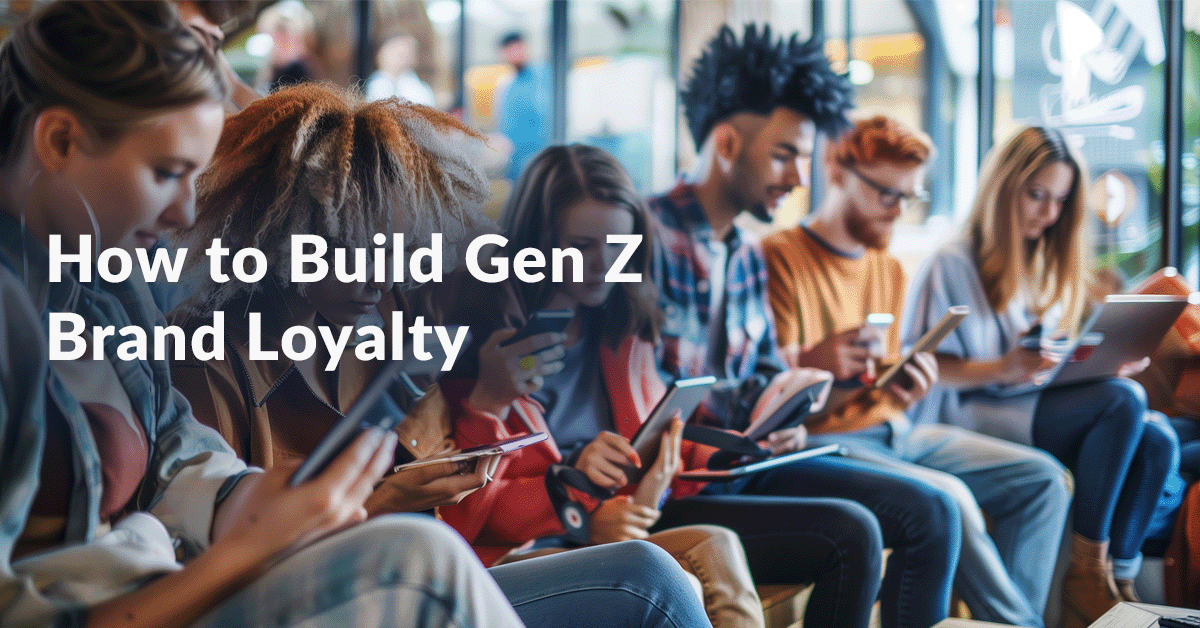Generation Z see things differently.
Born between 1997 and 2012, they’ve lived through unusual times. From economic uncertainty and political division to COVID-19 and hybrid working, they’ve had to overcome many challenges. And each one has helped to shape their attitudes, preferences, and behaviors – especially towards brands and customer loyalty programs.
Gen Z: A Growing Force
Gen Z makes up around 21% of the U.S. population, and experts predict they'll account for 27% of the workforce in OECD countries by 2025. Crucially, Gen Z has a combined spending power of over $360 billion as of 2021. That figure will almost certainly have increased in the years since and will continue to do so in the years ahead.
Put simply, you can no longer afford to overlook Gen Z.
Gen Z consumers have a combined spending power of over $360 billion, as of 2021 – and that figure will only increase in the years ahead.
Engaging With Gen Z
Before you can cultivate Gen Z brand loyalty, you need to understand what makes these savvy consumers tick.
Gen Z is the most racially and ethnically diverse of all generations. They see themselves as part of a global community, favoring brands that align with their values of authenticity, transparency, and inclusivity and boast strong online communities.
Beyond diversity and values, Gen Z consumers are typically well-informed. The first true digital natives, they judge brands on what they do, not what they say, and aren't afraid to hold brands that break their promises to account.
Traditional advertising isn’t as persuasive to Gen Z consumers as it is to older generations, and well-known brands don’t always have the advantage. As such, the factors that shape their preferences and purchasing habits most are:
- Social media
- Influencers & micro-influencers
- Friends and family
For example, they're more receptive to user-generated content (UGC) than traditional brand comms. It gives them a different perspective, allowing them to see brands through their peers’ eyes.
Growing up with social media means Gen Z consumers are more emotionally connected to their favorite brands. For them, communication works both ways, and they respect brands that encourage open dialogue and candid feedback.
“Gen Zers have grown up in the era of fake news. They are quick to spot misdirection and do not respond to hype. Instead, they are looking for brands to be transparent and authentic.”
8 Tips for Cultivating Gen Z Brand Loyalty
1. Focus on Values
Gen Z consumers favor brands that align with their values, prioritizing wellness and quality of experience over material factors. Research suggests that brands who share their customers’ views on key social, ethical, and environmental issues forge stronger emotional connections that transcend transactional loyalty. 62% of Gen Z consumers want to collaborate with brands on addressing social issues.
Harness this by incorporating environmental, social, and governmental (ESG) principles into your customer loyalty programs. This can come in many forms. For example, donating a percentage of qualifying purchases to charity, rewarding members for performing eco-friendly activities like recycling, or encouraging members to adopt healthy lifecycle practices.
73% of Gen Z consumers will pay more for sustainably made products.
2. Be Authentic and Transparent
Savvy and skeptical by nature, Gen Z consumers can smell corporate baloney from a mile away. More than any other generation, they respect brands that aren’t afraid to tell the world who they are and what they stand for.
One way to achieve this is to partner with influencers and embrace user-generated content. Encouraging customers to share their experiences and opinions builds confidence in your brand. Research shows that customers are 88% more likely to make repeat purchases from brands they trust.
61% of Gen Z consumers prefer UGC over traditional brand communications.
3. Personalize Your Programs
Having grown up in the age of big data , Gen Z consumers are accustomed to receiving personalized experiences – whether that's from their bank or their favorite brands. 62% are willing to pay a premium for tailored products and services, so great is their desire for personalization.
You can meet these expectations by leveraging your first-party data to understand individual preferences and deliver personalized products, services, offers, and content.
45% of Gen Z consumers will leave a website if it doesn't accurately predict their needs.
4. Provide Value for Money
Cost of living remains high on the priority list for Gen Z consumers, even more than climate change and mental health. According to a recent Deloitte survey, 60% live paycheck-to-paycheck, and this directly impacts how they shop with brands.
Gen Z consumers favor brands that offer high-quality products at reasonable prices. So, to earn and retain their business, your loyalty programs must deliver tangible value.
Of course, value is subjective. However, as habitual deal-seekers, offering discounts on everyday essentials goes a long way to earning Gen Z loyalty. Other enticing tactics include gift-with-purchase promotions, punch-card programs, and coupons they can put towards expensive items.
73% of Gen Z have altered their shopping habits due to inflation in response to rising prices.
5. Embrace Social Media
Traditional advertising channels like television and print don’t appeal to Gen Z consumers like they do to Gen X and boomers. When it comes to discovering new products or interacting with their favorite brands, Instagram and TikTok are fast becoming the platform of choice for Gen Z.
Lean into this by running limited-time social media contests or rewarding loyalty program members who like, follow, or share your content. Aside from strengthening customer relationships, this provides a valuable source of first-party data and helps to increase loyalty program sign-ups and participation.
Put simply, having a strong social media presence is no longer optional – it’s crucial for capturing market share and building brand loyalty among younger consumers.
Experts predict the social commerce market to reach $150 billion by 2028.
6. Partner with Influencers
Gen Z consumers are wary of traditional brand messaging and rely on friends, family, and especially influencers to help them discover new products. 37% of US consumers say they trust influencers over brands, with Gen Z and millennials twice as receptive as boomers. This is particularly noticeable in the fashion industry.
You can capitalize on this trend by inviting influencers to participate in your campaigns. For example, Adidas collaborates with influencers on product launches and special events to encourage consumers to promote new products, engage existing customers, and increase sign-ups for their loyalty program.
7. Gamify Your Programs and Promotions
Incorporating gamification into your programs and promotions is a highly effective way to cultivate Gen Z brand loyalty.
65% of Gen Zers spend at least three hours a day playing video games, with many saying it allows them to be their authentic selves. As a result, they’re as familiar with gaming mechanics as they are with Googling to find information.
Gamification works on many levels. For some, the rush of overcoming challenges and earning rewards makes gamified programs and promotions almost irresistible. For others, it’s all about the spirit of competition – the kudos that come with defeating their rivals and proving they’re the best.
Whatever the reason, gamifying your experiences gives Gen Z consumers a compelling reason to stick around. That could be by running competitions with leaderboards recognizing the top performers or rewarding members with badges as they reach new loyalty program tiers.
Brands that use gamification in their programs see a 47% increase in customer engagement and a 22% rise in loyalty.
8. Deliver Seamless Experiences
Gen Z consumers appreciate brands that adapt to their fast-paced lifestyles. Whether they’re searching for new products in-store or looking for support online, they expect smooth and consistent experiences from every interaction.
Creating a frictionless user journey goes beyond offering guest checkout. Integrating rewards and incentives directly into Gen Z’s preferred platforms, such as social media, increase customer engagement and satisfaction – the cornerstones of brand loyalty.
Harnessing advanced technologies, including receipt processing platforms to capture receipts for promotions and AI, allow you to provide more personalized recommendations, offers, and rewards based on first-party data. These technologies can also help you provide seamless omnichannel support, where users can switch between devices without disruption.
41% of Gen Z consumers favor brands that deliver timely and responsive customer support.
Gen Z Brand Loyalty Examples
#CleanTok (Unilever x TikTok)
@cleanipedia_uk Dirty Deeds Episode 1 – Someone's lurking in the shadows for Comfort Creations but who could it be…. 👀 #DirtyDeeds #Cleanipedia #Persil #Comfort #Cif
♬ original sound - Cleanipedia
Unilever's #CleanTok campaign racked up an incredible 98.5 billion views during its run. Featuring animated cleaning products, Dirty Deeds: A Kitchen Crime drove a 30% surge in traffic to Unilever's Cleanipedia portal and a 38% increase in Cif Cream purchases.
NASCAR Fan Rewards (NASCAR)
NASCAR transformed its Fan Rewards platform to include experience-based rewards, like fantasy leagues and race-day challenges, to engage fans beyond the racetrack. Since implementing the new strategy, average session length among program members has increased by 70%. At the same time, the brand has seen a threefold increase in click-through rate among non-members.
Sports Matter Giving Truck (Dick’s Sporting Goods)
Dick's Sporting Goods invested over $7 million in local leagues and schools to address the decline in youth sports participation. Their Sports Matter initiative donates essential sports equipment, reinforcing their mission to promote sports and build loyalty from a young age.
Spencer’s Nation (Spencer’s)
Spencer’s partners with Snipp to drive Gen Z brand loyalty and basket value. The Snipp loyalty platform makes it quick and easy for customers to ‘punch’ their virtual loyalty card – once they fill in their card, they can redeem it for free items in-store. This appeals to Gen Z’s preference for rapid and intuitive solutions on their devices.
The Future is Now
Gen Z is already one of the most important customer segments for brands. As their buying power increases in the coming years, they're on course to become the undisputed market leaders. With their unique outlook and values-driven mindset, learning how to adapt your customer loyalty strategy to meet their needs is essential.






